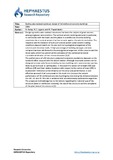| dc.contributor.author | Bakas, Nikolaos | |
| dc.contributor.author | Lagaros, N. D. | |
| dc.contributor.author | Papadrakakis, M. | |
| dc.date.accessioned | 2015-12-11T16:00:19Z | |
| dc.date.available | 2015-12-11T16:00:19Z | |
| dc.date.issued | 2006 | |
| dc.identifier.uri | http://hdl.handle.net/11728/6602 | |
| dc.description.abstract | Designing earthquake resistant structures has been the subject of great concern among engineers and scientists. The vertical seismic resisting elements in particular, in connection with the beam and the plates in a reinforced concrete building constitute the structural system that has to resist against the seismic excitation. The response and the behavior of such a structural system under seismic loading conditions depend mainly on the size and the topological arrangement of the columns and the shear walls. A high percentage of building damages and even collapses has been attributed to the wrong plan arrangement of the columns and the shear walls, which has permitted the activation of the combined torsional-translational vibration of the structural system [1,2].
The performance of a RC structure subjected to dynamic excitations depends on the torsional effect coupled with the lateral motion. Although structural systems can be designed to meet code forces including torsion, buildings with severe torsion are less likely to perform well in earthquakes. In this work the centers of strength (CV) and stiffness (CR) and their relative locations with respect to the center of mass (CM) is studied with reference to the influence on the structural performance. A cost-effective approach that is proposed in this study is to improve the seismic performance of 3D reinforced concrete buildings by minimizing the distance between the CM, CV and CR. This aim is achieved with an evolutionary optimization algorithm. The proposed methodology has no limitations regarding the material type of the structure (steel or reinforced concrete), the size of the structure and the complexity of the plan view of the structure [3]. | en_UK |
| dc.language.iso | en | en_UK |
| dc.publisher | WCCM | en_UK |
| dc.relation.ispartofseries | 7th World Congress on Computational Mechanics;Los Angeles, California, USA | |
| dc.relation.ispartofseries | ;July 16-22, 2006 | |
| dc.rights.uri | http://creativecommons.org/licenses/by-nc-nd/4.0/ | en_UK |
| dc.subject | Earthquake resistant | en_UK |
| dc.subject | 3d | en_UK |
| dc.subject | reinforced concrete | en_UK |
| dc.subject | buildings | en_UK |
| dc.title | Earthquake resistant optimum design of 3d reinforced concrete buildings | en_UK |
| dc.type | Working Paper | en_UK |


